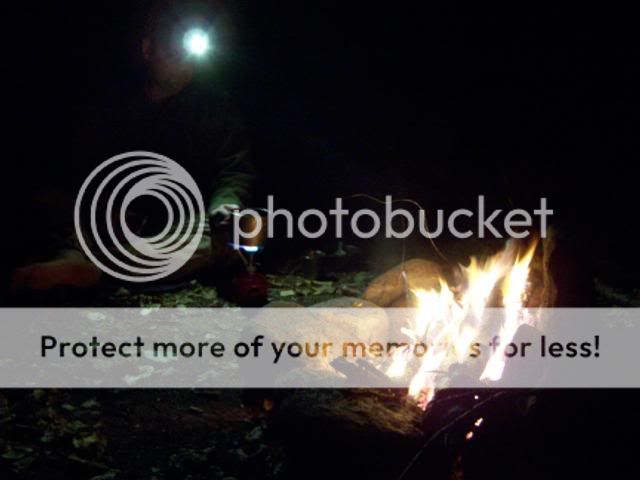Woods Walker
The Wood is cut, The Bacon is cooked, Now it’s tim
LED Thru-hike suggestions.
Over the summer I have completed around 120 miles on the Appalachian Trail during multi day hikes. But want to prepare for a true Thru-hike. For those not familiar with this here is some info.
http://en.wikipedia.org/wiki/Thru-hiking
Clearly 2165 miles over maybe 5 months is a long walk. I am gathering gear that is durable and lightweight. Over this summer I used my ZL H501w/H501-Q5 or Rebel EOS for a headlamp and Olight T15. My preference is for 1XAA lights but could go with other suggestions and battery types. I used LSD NiMH and sometimes CR123 if employing my T10 body for the Olight. On a longer trek I can't really depend on LSD NiMH despite having a Silva fold up solar charger. There is just not the time to mess around with this. Also CR123 is no go. AA Lithium primaries would be packed at first but as was the case this summer some of the places I hiked off trail like gas stations for supplies only had alkaline batteries. So the light must be able to function with these just incase I am forced to use them. So here are my preferences.
1. AA or AAA batteries.
2. Long runtimes.
3. True low and bright high.
4. Light weight and durable.
5. The flashlight should have reasonable throw.
6. Should use same batteries as my headlamp
If the light breaks I am not going to get a replacement from the seller even if covered under warrantee. Just too much fuss so the flashlight will have to work and keep on running. Am I ok with the current T15/H501w (my preference over the 2nd H501-Q5) or is there something better out there that is relatively trouble free for months of use? I have seen LED 2xAA Mags and 3XAAA headlamps on the trail at the lean-to shelters and people seemed to like them but think AA is better than AAA not that lights such as my Rebel LED EOS and E01 are beyond consideration.
So far I used the headlamp for camp work and the flashlight for night hikes. I promised myself these would be avoided but just last weekend I found myself hiking 4 hours in the dark. Just a month before hiked the last miles to the next shelter when running late. Needed throw to see the trail markers far off. So got to believe that there will be times when a night hike might happen even if this is not preferable.
Clearly my headlamp is going to do much of the work as was the case this summer. But posted this in the flashlight section for input on a flashlight as a backup and for greater output and throw than my headlamp can provide. Also unlike overnighters I would have a hard time justify multiple flashlights when I already have a headlamp. Any advice from Thru-hikers or anyone would be appreciated.
Over the summer I have completed around 120 miles on the Appalachian Trail during multi day hikes. But want to prepare for a true Thru-hike. For those not familiar with this here is some info.
http://en.wikipedia.org/wiki/Thru-hiking
Clearly 2165 miles over maybe 5 months is a long walk. I am gathering gear that is durable and lightweight. Over this summer I used my ZL H501w/H501-Q5 or Rebel EOS for a headlamp and Olight T15. My preference is for 1XAA lights but could go with other suggestions and battery types. I used LSD NiMH and sometimes CR123 if employing my T10 body for the Olight. On a longer trek I can't really depend on LSD NiMH despite having a Silva fold up solar charger. There is just not the time to mess around with this. Also CR123 is no go. AA Lithium primaries would be packed at first but as was the case this summer some of the places I hiked off trail like gas stations for supplies only had alkaline batteries. So the light must be able to function with these just incase I am forced to use them. So here are my preferences.
1. AA or AAA batteries.
2. Long runtimes.
3. True low and bright high.
4. Light weight and durable.
5. The flashlight should have reasonable throw.
6. Should use same batteries as my headlamp
If the light breaks I am not going to get a replacement from the seller even if covered under warrantee. Just too much fuss so the flashlight will have to work and keep on running. Am I ok with the current T15/H501w (my preference over the 2nd H501-Q5) or is there something better out there that is relatively trouble free for months of use? I have seen LED 2xAA Mags and 3XAAA headlamps on the trail at the lean-to shelters and people seemed to like them but think AA is better than AAA not that lights such as my Rebel LED EOS and E01 are beyond consideration.
So far I used the headlamp for camp work and the flashlight for night hikes. I promised myself these would be avoided but just last weekend I found myself hiking 4 hours in the dark. Just a month before hiked the last miles to the next shelter when running late. Needed throw to see the trail markers far off. So got to believe that there will be times when a night hike might happen even if this is not preferable.
Clearly my headlamp is going to do much of the work as was the case this summer. But posted this in the flashlight section for input on a flashlight as a backup and for greater output and throw than my headlamp can provide. Also unlike overnighters I would have a hard time justify multiple flashlights when I already have a headlamp. Any advice from Thru-hikers or anyone would be appreciated.


